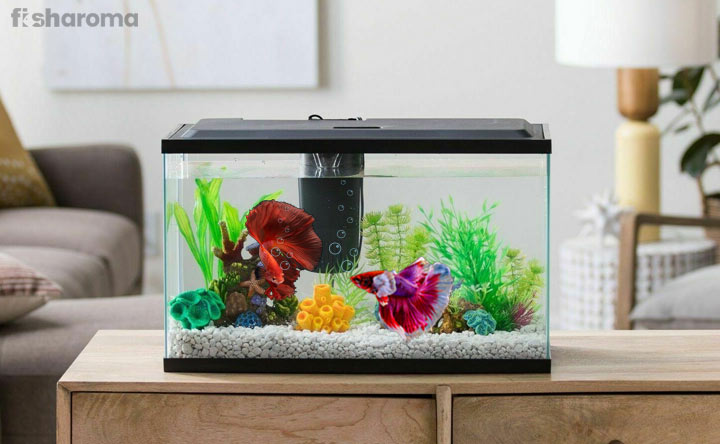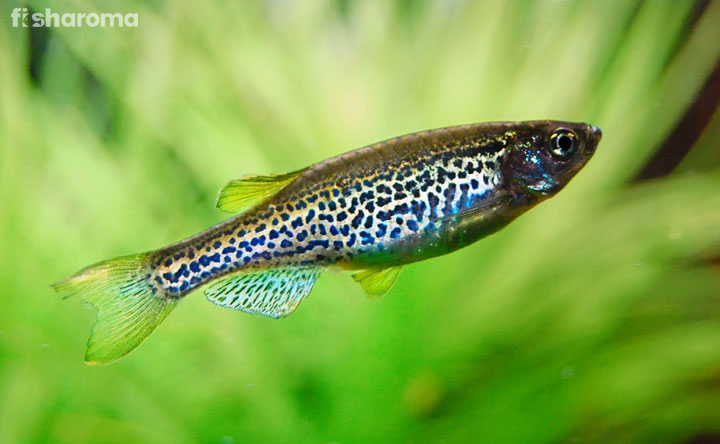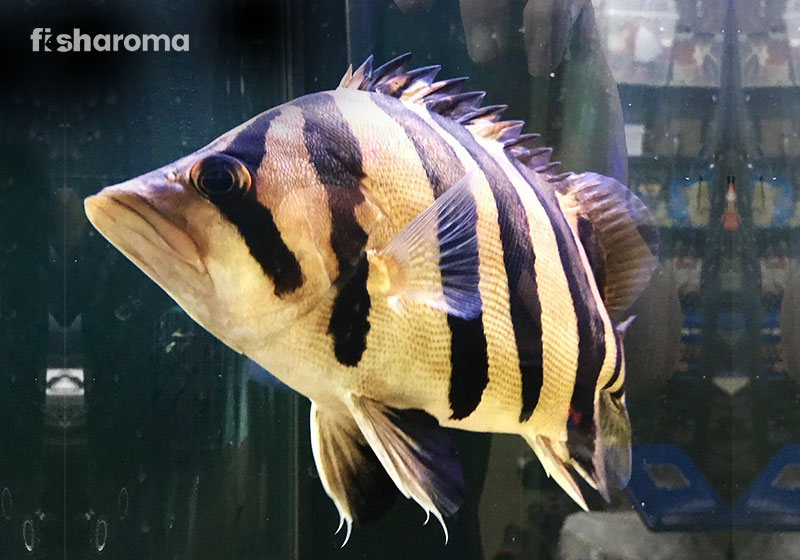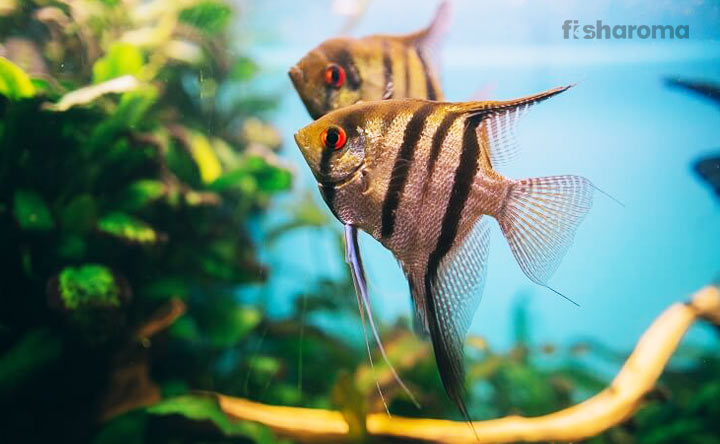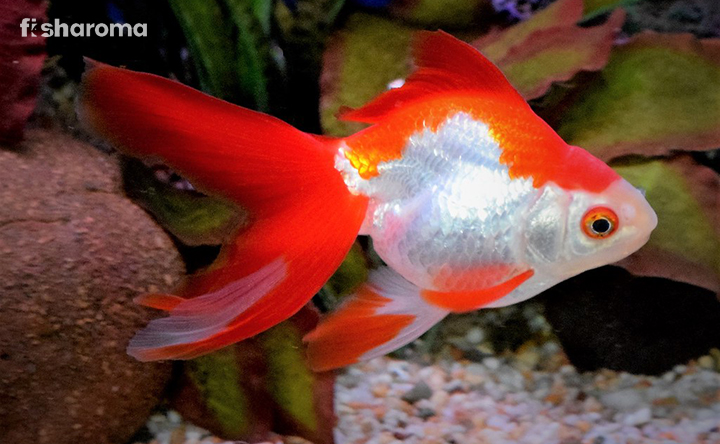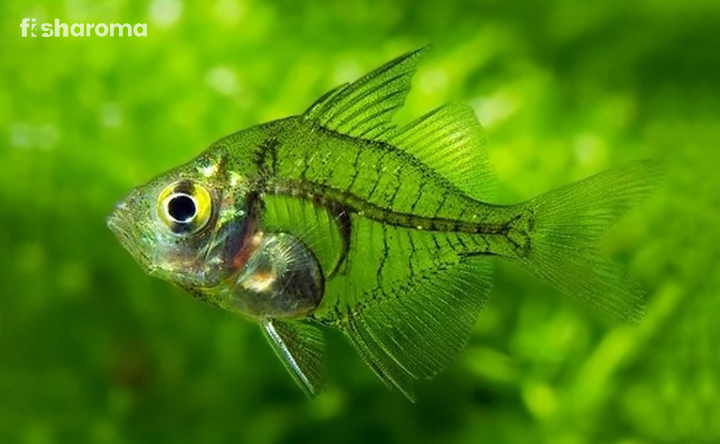Vampire Pleco: A Comprehensive Care Guide To This Striking And Fun Pleco Species
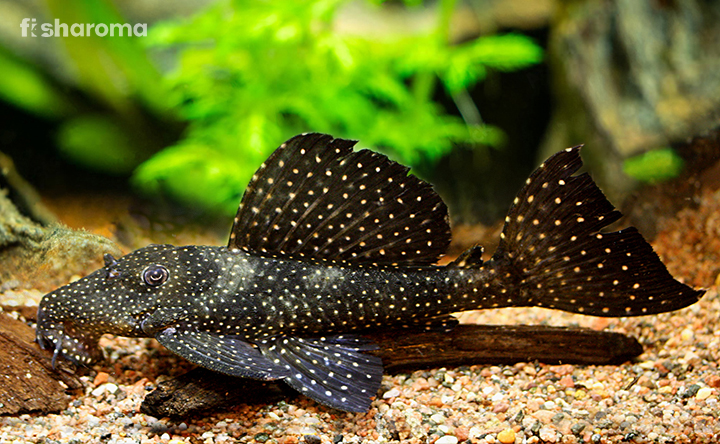
- Origin & Habitat of Vampire Pleco
- Appearance of Vampire Pleco
- Behaviour of Vampire Pleco
- Lifespan of Vampire Pleco
- Diet of Vampire Pleco
- Tank Requirements for Vampire Pleco
- Water Type for Vampire Pleco
- Compatibility of Vampire Pleco
- Breeding of Vampire Pleco
- Diseases and Treatment of Vampire Pleco
- Summary
Vampire Pleco is one of the most sensational types of armoured catfishes. With a gorgeously patterned coat and a calm demeanour, Vampire Pleco makes a great choice as a pet. These fishes can get quite large in size and so you can expect them to enhance the beauty of your tank profoundly.
Vampire Plecos are one common liking among many freshwater aquarists. Not only are they great to look at, but their presence will also tranquillize your mind.
If you are interested in having a Vampire Pleco as your pet, then you’re at the right destination! Here, we will provide you with expert information and guidance on their care guide, diet, behaviour, breeding and other fascinating facts.
So, follow through to know it all!
Key Specifications of Vampire Pleco
Vampire Plecos are such fascinating creatures! If you are really thinking about making them a part of your family, then the table below gives a brief outline of their primary characteristic traits! So, let’s use a have look at them!
| Scientific Name | Leporacanthicus Galaxias |
| Origin | Brazil, South America |
| Lifespan | 15 years |
| Colour | White spots on Black skin |
| Temperament | Peaceful |
| Size | 10 inches |
| Diet | Omnivore |
| Family | Loricariidae |
| Compatibility | Other similar-sized, peaceful fish |
| Tank Size | 50-75 Gallons |
| Care Level | Easy |
| Water Temperature | 22-26 Degrees Celsius |
| Water Conditions | pH 5.6-7 |
| Breeding | Egg-layer |
Overview
Vampire Plecos (Leporacanthicus Galaxias) are also commonly known as Tusken Pleco and Galaxy Pleco for their fascinating and starry-patterned skin tone. They belong to the Actinopterygii class and Siluriformes order. These species of Plecostomus are loved by many fish-enthusiasts. Not only are they tranquil by nature, but they are also easy to care for and equally attractive. Due to their elongated body shape and bony structure, these fishes are quite physically strong and are also very capable of embellishing your tank. Vampire Plecos are bottom feeders and they spend the majority of their time roaming around near the bottom of the tank.
Plecostomus, which is also commonly known as Suckermouth Catfish, includes different types of Pleco species. Each of these species has a diversified uniqueness to its existence. Learn more about the various types of Plecos.
Nevertheless, Vampire Plecos do require adequate care and maintenance. So, in this article, we will talk about those factors which are necessary for their survival in captivity.
Origin and Habitat of Vampire Pleco
Vampire Plecos have mainly been found swimming in the Orinoco drain in Colombia. They inhabit the freshwater rivers of Brazil, South America.
Their natural habitat includes plenty of aquatic vegetation and rocks. They survive the best in warmer water temperatures with a slightly acidic to neutral pH. They prefer a strong water current. Breeding is an exception as they require a much slower water-flow rate.
Appearance of Vampire Pleco
Vampire Plecos are extremely gorgeous. They have an enchantingly patterned coat about which we will discuss in the “colour” section.
These fishes have a hard and strong head, a flat underbelly and an elongated tail. The spined dorsal, caudal, pelvic and pectoral fins are quite well defined. The dorsal and the caudal fins, especially, are massive in size, which makes the fish look more magnificently beautiful.
These fishes have a suckermouth. The mouths aid in suction as the fish attach themselves to the crevices and rocks during a potential threat. The suction also helps them to stick their mouths to the glass walls of an aquarium when feeding on algae.
Vampire Plecos have omega iris in the pupils of their eyes. This allows them to shrink and accordingly adjust the amount of light entering their eyes.
Mature male Vampire Plecos have a longer and broader head than the females. Additionally, they have bigger and more prominently shaped dorsal fins. Also, you’ll notice that they have more odontodes than the females. A female Vampire Pleco, on the other shape, has a shorter body frame, with a slightly rounded belly, as they carry the eggs.
Size
A Vampire Pleco will reach a length of around 10 inches, provided they are given the proper care and diet. A Vampire Pleco will attain its full size within a span of 5 years.
Colour
Vampire Plecos have a gorgeous pattern on their skins. They are dark black and sometimes brown or grey in colour. The dark coat is adorned with small yellowish-white specks, which cover the entire part of their body.
Behaviour of Vampire Pleco
Vampire Plecos are very pacific and peaceable creatures. They spend most of their time at the bottom of the tank. Vampire Plecos are nocturnal and so, you will find them active at night. During the days, they act very timidly as they hide amidst the rocks and plants in the tank. At night, they come out of their caves and move around slowly near the bottom of tank scavenging for food and playing.
However, you need to pay attention to whether your Vampire Pleco is getting an adequate space to swim. In the presence of other bottom dwellers in the tank, there are high chances that your Vampire Pleco will exhibit territorial aggressiveness. So, an overcrowded tank, that too with little decor and flora, will present a problem as it may make your Vampire Pleco feel threatened and uncomfortable.
Lifespan of Vampire Pleco
Vampire Plecos can live up to 15 long years if given the proper care and provided with accurate water conditions. So, yes! Your Vampire Pleco will accompany you for quite some time!
Diet of Vampire Pleco
Vampire Plecos mainly follow a carnivorous diet in the wild. They love to devour protein-rich meaty foods. However, in an aquarium environment, you can also feed them veggies. Do make sure that you don’t restrict their diet to vegetables only, as they are more attracted to fleshy foods.
Vampire Plecos do often feed on algaes inside the tank. Howbeit, you should make sure that they don’t overfeed on algae as it is unhealthy for them.
Carnivorous Diet includes
- Brine Shrimp
- Bloodworms
- Chopped shrimps (market brought)
- Snails
- Prawns
Commercially Available Fish Food:
- Supplemented Vitamins
- Fish food with high protein content
- Fish Pellets and Flakes
- Dried and Frozen fish food
You can also feed them:
- Blanched vegetables
- Algae Tablets and Wafers
Tank Requirements for Vampire Pleco
Vampire Plecos do require keen attention and care. You should pay great heed to their tank conditions for ensuring that your fish lives a happy and healthy life. In this section, we will help you out with expert guidance and suggestions on how to set up your fish tank to confer them the best possible measures for their survival.
Tank Size
Vampire Plecos can get quite large in size. It is always recommended that you buy a tank of no less than 50 Gallons. If you house more than one adult Vampire Pleco, then consider getting a 75-100 Gallons tank. You should choose the perfect fish tank for your pet fish.
Tank Shape
Vampire Plecos are bottom-dwellers. Also, they require enough hiding places. So, you should definitely get your Vampire Pleco a rectangular shaped tank. This will allow them to relax, explore and move around the tank freely.
Tank Lid
Tank Lids are a must when it comes to taking good care of your pet fish. Your Vampire Pleco may jump out of the tank and suffocate to death. Other than that, you also would want to keep your tank safe and clean from all the air-borne foreign substances and dust particles. Therefore, tank lids are an absolute necessity.
Additionally, if you have other pets at home, like a dog or a cat, a strong tank lid will protect your Vampire Pleco from any sort of attack.
Make sure that the tank lid is tightly closed.
Substrate
Vampire Plecos are bottom-dwellers and so, you need to make sure that you’re choosing the right substrate materials. Soft, sandy substrate and fine gravel would do just fine. Ensure that the substrate particles aren’t rough and sharp-edged as they may cause injuries to your fish and can be fatal.
Additionally, since Vampire Gouramis have a darker skin tone, you should go for lightly coloured substrates as they will amplify the fish’s beauty.
Filter
Vampire Plecos require adequate ventilation and a high concentration of oxygen to survive. You need to get strong filtration techniques for your Vampire Pleco tank which will equally purify the water, removing all the toxins and wastes.
You should install powerheads that improve the water circulation within the tank and hence the oxygen concentration. Furthermore, the addition of two or more bio-wheel filters will keep track of the ammonia and nitrate concentration.
Ornaments
For your Vampire Pleco tank, you must add plenty of hide-out places including caves, soft rocks and driftwoods. Vampire Plecos are shy creatures and so they really spend most of their time hiding, especially during the day.
Additionally, driftwood acts as a great source of fibre for them.
However, do make sure not to overcrowd the tank with decorations. Vampire Plecos love to swim and move around freely.
Lighting
Since vampire Plecos are nocturnal and bottom-dwellers, they are habituated to low light regions. So, try to maintain a moderate to low light intensity inside your aquarium.
Keep the aquarium light on for 8 hours daily. That’ll be enough.
Presence of Flora
Vampire Plecos prefer dense aquatic vegetation as it gives them comfort and adequate space to hide. You should decorate your aquarium with live plants including Moneywort, Hornwort, Anubias Nana, Java Fern and Java Moss.
Cleaning Method
To clean your tank, first and foremost, ensure that you have installed a proper filtration system. A strong filter will allow good ventilation and remove debris and decomposable wastes as well.
Additionally, make sure that you change 10% of the tank water at least once a week.
Clean the inside of the tank glass/acrylic walls to remove the algae stuck on them.
Furthermore, we recommend that you use an aquarium vacuum cleaner which will suck out all the accumulated debris from within the substrate layers.
Water Types for Vampire Pleco
The tank water conditions have a great impact on the lifestyle of a Vampire Pleco. Even a slight, undesirable alteration in the water parameters will pose a threat to their lives. Firstly, make sure to fully cycle your aquarium, before introducing your Pleco to the tank. So, in this section, we will talk about the water requirements for a Vampire Pleco.
Water Temperature
Vampire Plecos thrive the best in warm water temperatures. Inside the aquarium, you should maintain the water temperature between 22-26 Degree Celsius. Use the best heater and aquarium thermometer to maintain, regulate and check your aquarium temperature.
pH Level
Vampire Pleco survives at a water pH between 5.6 to 7. They require slightly acidic to neutral pH and so, make sure that the pH doesn’t go above 7 as it will make the water basic and harm your fish.
So, you must maintain the proper pH level inside the tank.
Hardness
For a Vampire Pleco, you need to make sure that the water hardness lies anywhere between 8-12 KH.
Water Flow Rate
Vampire Plecos require a strong water current. So, you can install a pump inside your tank to maintain the flow rate of water.
Compatibility of Vampire Pleco
Vampire Plecos are community fishes and are very peaceful. They won’t readily start a fight with any other fish. They would rather act quite welcoming and for the most part, mind their own business. These fishes could spend the rest of their lives in peace with other tank mates who are equally calm and not aggressive.
However, do ensure that you avoid adding other bottom-dwellers to your tank. This approach will make your Vampire Pleco feel threatened and will in turn kindle a territorial fight. It is best if you choose fishes that mostly swim near the middle and the top layer of the tank.
Suitable Tank Mates
- Black Skirt Tetra
- Neon Tetra
- Angelfish
- Guppy Fish
- Rainbowfish
- Silver Dollar Fish
- Platy Fish
- Bolivian Ram Cichlid
- Red Shoulder Severum
- Red Eye Tetra
- Molly Fish
Unsuitable Tank Mates
Breeding of Vampire Pleco
For breeding, you need a separate tank solely for that purpose. Get a 100-gallon tank and make sure to add plenty of hiding places, including soft rocks, caves, driftwood and plants. You need to ensure that the ambience within the breeding tank mimics their natural habitat.
Breeding Parameters
Make sure to perform slow water alterations. Renew the water of the tank at a cooler temperature. The temperature should be between 22.2 and 25.5 Degrees Celsius. The water current should be very low, so adjust the pump water flow accordingly. The powerheads inside the tank should be directed towards the place where the mating is taking place to ensure that there is adequate oxygenation.
Breeding Process
Once the water conditions are favourable, the fishes will begin the process of breeding. The female Vampire Plecos will lay the eggs on and near the surface of the caves and rocks. After spawning, separate the adults from the breeding tank to save the eggs.
How to take Care of the Fries?
Vampire Pleco eggs hatch within 5-7 days after spawning. Newborn Plecos will initially feed on the yolk sac, absorbing the essential nutrients. After this phase, you can feed them baby brine shrimps, powdered food and crushed flakes. Make sure that the water quality is at its optimum, with proper oxygenation, filtration and purification.
Disease and Treatment of Vampire Pleco
There are certain common freshwater diseases that can affect your Vampire Pleco. So, let’s have a look at the diseases and their treatments.
Ich
Ich is one of the most common freshwater diseases. This disease is caused by certain parasites and the noticeable symptoms include small white spots all over the fish’s body, lethargy and loss of appetite.
To treat this disease, make sure that you first isolate the infected fish to a separate tank. Then, you need to change the water in the tank at regular intervals. Use a sponge to remove dirt from the inside of the glass walls. Use a proper filtration system to rid the tank of all the debris, waste products and toxin.
Consult the vet if the infection still persists.
Dropsy, Fin and Tail Rot
These types of freshwater diseases are caused by certain bacteria. These diseases are a result of unhygienic tanks and water conditions. You’ll notice that your fish has lost the colouration on its body.
To treat this disease, you should clean the tank at regular intervals and change 25% of the tank water on alternate days.
Consult the vet if the problems take a serious turn.
Pop-Eye and Head Holes
These freshwater diseases are caused by bacteria as well. The noticeable symptoms include protrusion of the fish’s eyeball and numerous small cavities on and near the fish’s head.
Treatments include cleaning the tank regularly and changing the water frequently. Medications include vitamin supplements and tetracycline.
Nevertheless, always consult your vet if the problem persists.
Fungal Disease
Just like the above-mentioned diseases, fungal diseases are a result of unhygienic and poor tank conditions as well. The symptoms include grey and white spots all over the fish’s body.
To treat, keep your tank clean, use a proper filtration technique and change the tank water at regular intervals.
Consult an expert vet for further assistance.
Summary
On a closing note, Vampire Plecos would make a great addition to your tank. They have a very calm demeanour and are enchantingly beautiful. Vampire Plecos would even come out as an easy choice for beginner aquarists. Additionally, as we have seen before, Vampire Plecos live up to 15 long years! So, cheers! You have a friend who’ll accompany you for a really long period of time.
Vampire Plecos don’t pose much hassle as they love to mind their own business, roaming around slowly and serenely at the bottom of the tank. Also, they are tremendously gorgeous to look at! Even a single Vampire Pleco will lighten up your tank!
So, all the best as you go ahead with your decision of getting a Vampire Pleco for your freshwater aquarium. Make sure to take good care of them and provide them with a healthy lifestyle.
Similar Care Guides
If this article interests you then, don’t forget to visit our sites for further care guides for different fishes.
- Care Guide for Sailfin Pleco: These species of Plecos will surely adorn your tank as they have a gorgeously patterned coat. They are equally easy to care for and would make a great company.
- Care Guide for Nerite Snails: Nerite Snails are popular bottom-dwellers and they would surely be a great addition to your tank. They are pretty gentle, do not cause any trouble and are quite easy to deal with.
- Care Guide for Neon Tetra: These freshwater fishes are popularly known for their peaceful demeanour. Additionally, they have a vibrant colouration to their skins and are quite hardy.

